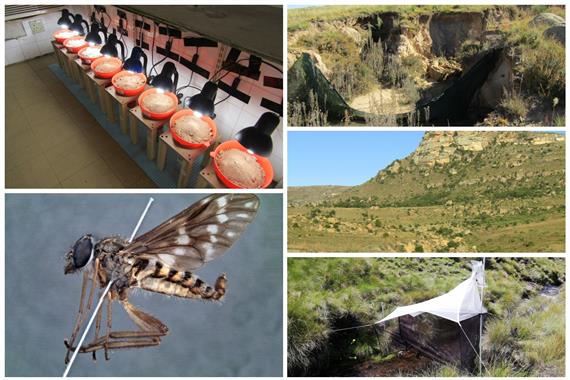Dipterology: Various aspects of Dipterology with the focus on taxonomy of Vemileonidae and Culicidae. Research also includes Diptera species that are of medical and veterinary importance and other that are serious agricultural pests (e.g. Tephritidae)
Environment Entomology: The interaction of insects with the biological, chemical, and physical aspects of their environment with specific focus on soil mesofauna.
Study group members
Dr Vaughn Swart
Postgraduate students and research titles
MSc Students
Gary Edwards
"Assessment Of Soil Macrofauna In Pecan Orchards For Potential Links To Overall Decline"
Research aims to assess whether soil macrofauna have a role in the phenomenon of overall decline affecting pecan trees in South Africa. Soil samples are taken from beneath healthy trees, and trees showing symptoms of overall decline. Organisms are extracted from soil samples and identified to determine whether there are any significant differences as well as if any potentially detrimental organisms are present.
Liezl Whitehead
"Molecular phylogeny of South African Aedes, Anopheles and Culex (Diptera: Culicidae) based on COI, ITS2 and 28S DNA sequences"
Little research has been conducted on the phylogenetic relationships of South Africa’s mosquitoes of medical and veterinary importance. Therefore, the current study aims to investigate the molecular phylogeny and genetic diversity of South African Aedes, Anopheles and Culex based on multiple gene regions. In addition to the potential applications of phylogeny relating to biodiversity, biogeography and evolution, this study would also provide the opportunity to gather up-to-date data on the community composition, distribution and habitat association of disease vectors, creating a foundation for future vector control efforts.
PhD Students
Sylvia van der Merwe
"Soil biota as bioindicators of levels of erosion and fire disturbances in Afromontane grassland areas within the Golden Gate Highlands"Soil erosion and grassland wildfires remain problematic throughout terrestrial ecosystems worldwide. While the effects of fire and erosion have been investigated across a variety of habitats and fauna, little attention has been given to their effects on soil-dwelling arthropods. This thesis sought to determine the state of soil-dwelling arthropods across eroded and currently rehabilitated localities, as well as their responses to fire regimes, in the Golden Gate Highlands National Park (GGHNP). Fire-treated and non-rehabilitated eroded sites showed a surprising attribute in that these habitats support a greater soil arthropod species richness and abundance than natural sites. These sites show potential as important environments that act as unique niches in the GGHNP, vital to supporting soil arthropod diversity in the soil environments of the park.

Jason Botham
"Investigation of interspersed shrubland patches along different topographical conditions within Afromontane grasslands, and their potential as conservation hotspots"The mountainous Golden Gate Highlands National Park (GGHNP) possesses a number of smaller, isolated shrubland patches, providing several habitat types over a relatively small geographical area. While these shrubland patches have been acknowledged as areas of possible significance in the GGHNP, information on arthropod assemblages in these patches remains limited. This thesis investigated arthropod assemblages in these smaller shrubland patches, in response to various environmental factors, and provided a preliminary view of the current state of gene flow among five ubiquitous spider species occurring in these shrubland patches. Arthropod assemblage composition and richness were noted to be highly influenced by vertical habitat stratification in the shrubland patches, alongside seasonal and temporal change with soil arthropod assemblage results indicating a higher association of soil biota with the shrubland patches compared to the adjacent grasslands. Furthermore, relatively low nucleotide diversity, with a correspondingly high genetic diversity, was observed within populations for all investigated spider species except one, and differing genetic differentiation indicated gene flow as being maintained, to a certain degree, between populations of these species, despite the mountainous terrain of the park. Overall, the results of this thesis provided a unique insight into the state of arthropod diversity, and their association with shrubland patches of the GGHNP, highlighting their continued significance as areas of priority management.
Burgert Muller
"Systematics of Afrotropical water snipe flies (Diptera: Athericidae)"The aim of the study is to elucidate the systematic and taxonomic relationships of the water snipe flies of the Afrotropical Region. South Africa in particular has several endemic genera and species, and one major component of the thesis will be to see where these endemics fit into the larger Afrotropical picture of the taxon through constructing a molecular phylogeny, as well as traditional morphological character study.
Fourie De Villiers
"Investigation of possible pyrethroid resistance development in two-spotted stinkbug, Bathycoelia distincta (Hemiptera: Pentatomidae) on Macadamia in South Africa."
Over several growing seasons, growers raised concerns of severe efficacy loss regarding synthetic pyrethroid applications on macadamia. Evidence points to the development of insecticide resistance in naturally occurring stink bug populations, a key-pest on macadamia. The study investigates several populations with the aim of establishing the existence of resistance, identify the mode of resistance through genetic sequencing and provide a holistic management program to growers concerning resistance management.